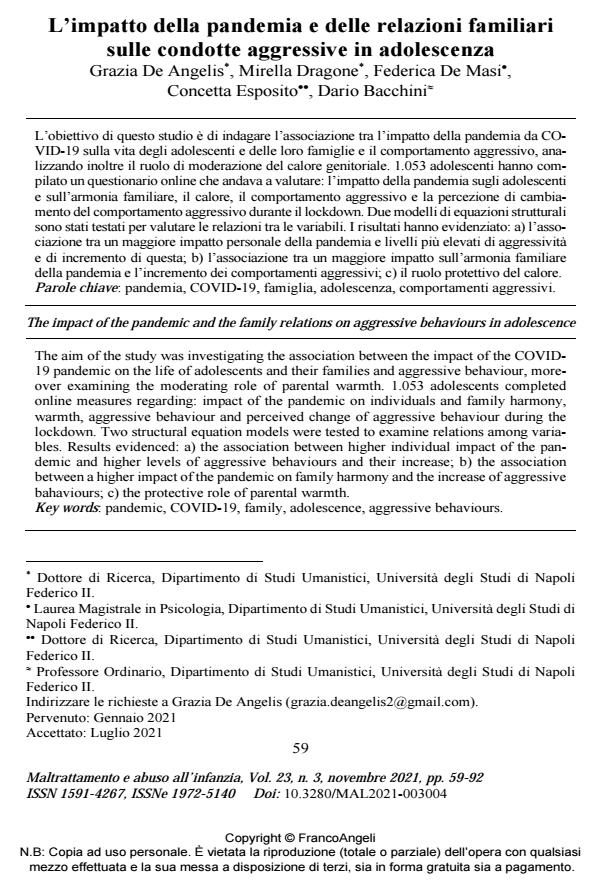L’impatto della pandemia e delle relazioni familiari sulle condotte aggressive in adolescenza
Titolo Rivista MALTRATTAMENTO E ABUSO ALL’INFANZIA
Autori/Curatori Grazia De Angelis, Mirella Dragone, Federica De Masi
Anno di pubblicazione 2021 Fascicolo 2021/3
Lingua Italiano Numero pagine 34 P. 59-92 Dimensione file 382 KB
DOI 10.3280/MAL2021-003004
Il DOI è il codice a barre della proprietà intellettuale: per saperne di più
clicca qui
Qui sotto puoi vedere in anteprima la prima pagina di questo articolo.
Se questo articolo ti interessa, lo puoi acquistare (e scaricare in formato pdf) seguendo le facili indicazioni per acquistare il download credit. Acquista Download Credits per scaricare questo Articolo in formato PDF

FrancoAngeli è membro della Publishers International Linking Association, Inc (PILA)associazione indipendente e non profit per facilitare (attraverso i servizi tecnologici implementati da CrossRef.org) l’accesso degli studiosi ai contenuti digitali nelle pubblicazioni professionali e scientifiche
L’obiettivo di questo studio è di indagare l’associazione tra l’impatto della pandemia da COVID-19 sulla vita degli adolescenti e delle loro famiglie e il comportamento aggressivo, analizzando inoltre il ruolo di moderazione del calore genitoriale. 1.053 adolescenti hanno compilato un questionario online che andava a valutare: l’impatto della pandemia sugli adolescenti e sull’armonia familiare, il calore, il comportamento aggressivo e la percezione di cambiamento del comportamento aggressivo durante il lockdown. Due modelli di equazioni strutturali sono stati testati per valutare le relazioni tra le variabili. I risultati hanno evidenziato: a) l’associazione tra un maggiore impatto personale della pandemia e livelli più elevati di aggressività e di incremento di questa; b) l’associazione tra un maggiore impatto sull’armonia familiare della pandemia e l’incremento dei comportamenti aggressivi; c) il ruolo protettivo del calore.
Parole chiave:pandemic, COVID-19, family, adolescence, aggressive behaviours.
- Filial responsibilities and psychological wellbeing among Chinese adolescents in poor single-mother families: does parental warmth matter? Janet T. Y. Leung, Daniel T. L. Shek, in Frontiers in Psychology 1341428/2024
DOI: 10.3389/fpsyg.2024.1341428
Grazia De Angelis, Mirella Dragone, Federica De Masi, L’impatto della pandemia e delle relazioni familiari sulle condotte aggressive in adolescenza in "MALTRATTAMENTO E ABUSO ALL’INFANZIA" 3/2021, pp 59-92, DOI: 10.3280/MAL2021-003004